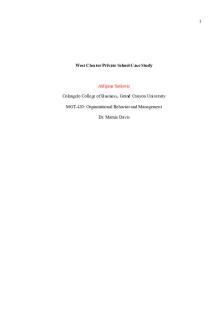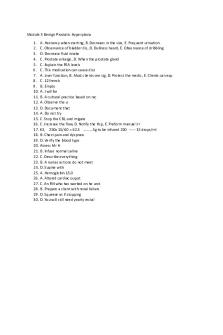Module 03 Case Study Columbine School Shooting PDF

| Title | Module 03 Case Study Columbine School Shooting |
|---|---|
| Author | Salha Altawil |
| Course | Criminal Behaviour |
| Institution | Carleton University |
| Pages | 3 |
| File Size | 56.9 KB |
| File Type | |
| Total Downloads | 63 |
| Total Views | 142 |
Summary
module 3 pt 2 summary ...
Description
Module 03: Case Study: Columbine School Shooting Craig Bennell: All right, guys, so the case study that we're going to talk about for this module, I think many of you would not have been old enough probably to remember this happening live, but I'm sure most of you did see this in the news since it happened. The case study is going to be the Columbine school shooters. There were two shooters in this particular case, Eric Harris and Dylan Klebold. And this is a photograph of the high school, Columbine High School. I believe that this photograph was taken after the incident, after some renovations were done. Of course, because of the incident, the school looked in pretty rough shape as a result of the shooting. So this is, I think, a renovated picture. So, as I'm sure most of you know, this is a school shooting case. It occurred in Columbine High School, which is a high school in Colorado. It took place on April 20th, 1999. And again, as I said, there were two shooters. 12 students and one teacher ended up being killed as a result of this shooting. And many more individuals were injured. Of course, the perpetrators in this particular case committed suicide. And that actually is often the end result of these sorts of cases. Often, the perpetrators of mass murder often commit suicide, or they end up being killed by law enforcement. At the time, this was one of the deadliest school shootings in US history. I think Virginia Tech, the school shooting at Virginia Tech has since taken it over in terms of casualties. And at the time, this led to a lot of debate in the US, which is still ongoing as to access to guns and the role of gun control in incidents like this. From our perspective in terms of this course, and the reason we're giving this case study is so that we can try to start to understand these sorts of cases, start to understand the behavior exhibited by these individuals, start to use psychological theories of criminal behavior to try to understand these sorts of incidents. So, in this particular case, the motive for the attack is actually not 100% clear. It's very difficult in these sorts of cases understanding motive because as I said, oftentimes in these cases, the perpetrators do not survive so we can't ask them about the motivation for the attack. There are a few cases where perpetrators of these sorts of incidents did
survive. There was a school shooting, for example, that occurred in Oregon where that individual is still alive. And of course, that makes it much easier as psychologists to try to understand what led to the event and what were the primary motivations. In this particular case, we can simply rely on archival data to try to understand the motives. So, these two individuals did leave personal journals and blogs. And certainly, the contents of those journals and blogs do give us some clues as to why these individuals committed this particular act. From those journals and blogs, it seemed that they wanted to rival the 1995 Oklahoma City bombing by Timothy McVeigh and Terry Nichols. And in fact, the Columbine school shooting, many reports suggest that initially, it was intended to be a mass bombing, but the bombs actually didn't go off and it ended up being the event that transpired. And essentially, from these individuals' journals and blogs, it seemed that they wanted to be basically infamous. They wanted to go down in history as wreaking such havoc that they would be remembered for all time, which is obviously quite sad. From a psychological perspective, when trying to understand these two individuals, certainly, different psychological issues seem to characterize the offenders. They seemed to be quite different from one another. And certainly, one of them seemed to be a leader, and one was a follower. Klebold, for example, if you read writings about him and by psychologists and in the media, Klebold it is probably best characterized as being a very angry individual, being very depressed. There is some evidence that he was suicidal. And all indications are that he was actually the follower in the team. Harris, on the other hand, is a much more difficult person to understand. And most describe him as extremely cold, very calculating, very cold-blooded. Some describe him as being psychopathic, so lacking in remorse and empathy and guilt and so on. And again, every indication is that Harris is the one that was the leader of the duo. A lot of people suggest that it was just Klebold, the incident, in fact, would not have happened. Again, we're trying to understand these issues from a psychological perspective, which is why we're giving this case study within the context of this particular module. And certainly, the information on the previous slide can give us some insight psychologically as to why these individuals maybe did what they did. In addition to that, certainly after this event took place, if you watched the news after it took place, a lot of experts were coming out and talking about this case. And many of them were pointing out the fact that these two individuals seemed to enjoy a lot of music and video games and movies that may have prompted this act.
Certainly from a social learning perspective, and we'll get to social learning later on in the module, there are some interesting issues here that I think we need to consider. For example, both of the offenders were fans of violent video games. They often mentioned Doom in their blogs and personal journals, and often suggested that the Columbine incident would be just like Doom. Both of the perpetrators were fans of quite violent movies, in particular, Natural Born Killers, a Oliver Stone movie following a couple that were committing spree killings across the United States, so an extremely violent movie. And they also listened to music by an obviously well-known musician, Marilyn Manson. And certainly, in Marilyn Manson songs are all sorts of violent themes. So, a lot of experts were pointing to these influences and suggesting that they may have played some role in the Columbine school shooting. I think the research since this time has suggested that certainly being exposed to these sorts of influences is probably not a help. It probably does encourage antisocial behavior. But I don't think the research is very clear that simply being exposed to these sorts of sources will cause someone to do this sort of thing that the Columbine school shooters did. It's simply a facilitator. If you already have an antisocial individual and you layer on top of that exposure to these sorts of influences, it may facilitate or encourage antisocial behavior. But it's probably not what directly causes someone to commit the sorts of acts that we saw committed by these two individuals. So, as we go through this module, think about this case study, think about the various psychological theories that we're talking about, and try to determine the various ways in which they may help explain the actions exhibited by these two offenders....
Similar Free PDFs

School Shooting Essay - good
- 2 Pages

Case study-Holmes School
- 3 Pages

#03 CASE Study sebastiao salgado
- 1 Pages

Columbine
- 11 Pages

FIN320 Module 4 Case Study
- 5 Pages

Module 3 Case Study Answers
- 6 Pages

Module 2 ARDS Online CASE Study
- 24 Pages

Bowling for Columbine Summary
- 2 Pages

FIN 320 Module 4 Case Study
- 6 Pages
Popular Institutions
- Tinajero National High School - Annex
- Politeknik Caltex Riau
- Yokohama City University
- SGT University
- University of Al-Qadisiyah
- Divine Word College of Vigan
- Techniek College Rotterdam
- Universidade de Santiago
- Universiti Teknologi MARA Cawangan Johor Kampus Pasir Gudang
- Poltekkes Kemenkes Yogyakarta
- Baguio City National High School
- Colegio san marcos
- preparatoria uno
- Centro de Bachillerato Tecnológico Industrial y de Servicios No. 107
- Dalian Maritime University
- Quang Trung Secondary School
- Colegio Tecnológico en Informática
- Corporación Regional de Educación Superior
- Grupo CEDVA
- Dar Al Uloom University
- Centro de Estudios Preuniversitarios de la Universidad Nacional de Ingeniería
- 上智大学
- Aakash International School, Nuna Majara
- San Felipe Neri Catholic School
- Kang Chiao International School - New Taipei City
- Misamis Occidental National High School
- Institución Educativa Escuela Normal Juan Ladrilleros
- Kolehiyo ng Pantukan
- Batanes State College
- Instituto Continental
- Sekolah Menengah Kejuruan Kesehatan Kaltara (Tarakan)
- Colegio de La Inmaculada Concepcion - Cebu






